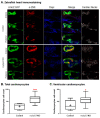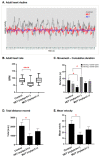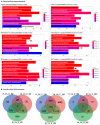Transcriptome Profile Identifies Actin as an Essential Regulator of Cardiac Myosin Binding Protein C3 Hypertrophic Cardiomyopathy in a Zebrafish Model
- PMID: 36012114
- PMCID: PMC9408294
- DOI: 10.3390/ijms23168840
Transcriptome Profile Identifies Actin as an Essential Regulator of Cardiac Myosin Binding Protein C3 Hypertrophic Cardiomyopathy in a Zebrafish Model
Abstract
Variants in cardiac myosin-binding protein C (cMyBP-C) are the leading cause of inherited hypertrophic cardiomyopathy (HCM), demonstrating the key role that cMyBP-C plays in the heart's contractile machinery. To investigate the c-MYBPC3 HCM-related cardiac impairment, we generated a zebrafish mypbc3-knockout model. These knockout zebrafish displayed significant morphological heart alterations related to a significant decrease in ventricular and atrial diameters at systolic and diastolic states at the larval stages. Immunofluorescence staining revealed significant hyperplasia in the mutant's total cardiac and ventricular cardiomyocytes. Although cardiac contractility was similar to the wild-type control, the ejection fraction was significantly increased in the mypbc3 mutants. At later stages of larval development, the mutants demonstrated an early cardiac phenotype of myocardium remodeling, concurrent cardiomyocyte hyperplasia, and increased ejection fraction as critical processes in HCM initiation to counteract the increased ventricular myocardial wall stress. The examination of zebrafish adults showed a thickened ventricular cardiac wall with reduced heart rate, swimming speed, and endurance ability in both the mypbc3 heterozygous and homozygous groups. Furthermore, heart transcriptome profiling showed a significant downregulation of the actin-filament-based process, indicating an impaired actin cytoskeleton organization as the main dysregulating factor associated with the early ventricular cardiac hypertrophy in the zebrafish mypbc3 HCM model.
Keywords: HCM; RNA seq; actin; c-MYBPC3; hypertrophic cardiomyopathy; zebrafish knockout.
Conflict of interest statement
The authors declare no conflict of interest.
Figures








Similar articles
-
Hypertrophic cardiomyopathy-linked variants of cardiac myosin-binding protein C3 display altered molecular properties and actin interaction.Biochem J. 2018 Dec 14;475(24):3933-3948. doi: 10.1042/BCJ20180685. Biochem J. 2018. PMID: 30446606
-
Functional characterization of human myosin-binding protein C3 variants associated with hypertrophic cardiomyopathy reveals exon-specific cardiac phenotypes in zebrafish model.J Cell Physiol. 2020 Nov;235(11):7870-7888. doi: 10.1002/jcp.29441. Epub 2020 Jan 13. J Cell Physiol. 2020. PMID: 31943169
-
Variable cardiac myosin binding protein-C expression in the myofilaments due to MYBPC3 mutations in hypertrophic cardiomyopathy.J Mol Cell Cardiol. 2018 Oct;123:59-63. doi: 10.1016/j.yjmcc.2018.08.023. Epub 2018 Aug 28. J Mol Cell Cardiol. 2018. PMID: 30170119
-
The mechanics of the heart: zooming in on hypertrophic cardiomyopathy and cMyBP-C.FEBS Lett. 2022 Mar;596(6):703-746. doi: 10.1002/1873-3468.14301. Epub 2022 Feb 28. FEBS Lett. 2022. PMID: 35224729 Review.
-
[Familial hypertrophic cardiomyopathy: genes, mutations and animal models. A review].Invest Clin. 2004 Mar;45(1):69-99. Invest Clin. 2004. PMID: 15058760 Review. Spanish.
Cited by
-
Deciphering metabolomics and lipidomics landscape in zebrafish hypertrophic cardiomyopathy model.Sci Rep. 2024 Sep 19;14(1):21902. doi: 10.1038/s41598-024-72863-5. Sci Rep. 2024. PMID: 39300306 Free PMC article.
-
Myocardial dysfunction caused by MyBPC3 P459fs mutation in hypertrophic cardiomyopathy: evidence from multi-omics approaches and super-resolution imaging.Front Cardiovasc Med. 2025 Feb 27;12:1529921. doi: 10.3389/fcvm.2025.1529921. eCollection 2025. Front Cardiovasc Med. 2025. PMID: 40083819 Free PMC article.
-
Disparate Molecular Properties of Two Hypertrophic Cardiomyopathy-Associated cMyBP-C Mutants Reveal Distinct Pathogenic Mechanisms Beyond Haploinsufficiency.Biomedicines. 2025 Apr 22;13(5):1010. doi: 10.3390/biomedicines13051010. Biomedicines. 2025. PMID: 40426840 Free PMC article.
-
MYBPC3 deficiency in cardiac fibroblasts drives their activation and contributes to fibrosis.Cell Death Dis. 2022 Nov 10;13(11):948. doi: 10.1038/s41419-022-05403-6. Cell Death Dis. 2022. PMID: 36357371 Free PMC article.
-
Experimental Models of Hypertrophic Cardiomyopathy: A Systematic Review.JACC Basic Transl Sci. 2025 Apr;10(4):511-546. doi: 10.1016/j.jacbts.2024.10.017. Epub 2025 Jan 15. JACC Basic Transl Sci. 2025. PMID: 40306862 Free PMC article. Review.
References
-
- Maron B.J., Gardin J.M., Flack J.M., Gidding S.S., Kurosaki T.T., Bild D.E. Prevalence of hypertrophic cardiomyopathy in a general population of young adults. Echocardiographic analysis of 4111 subjects in the CARDIA study. Coronary artery risk development in (young) adults. Circulation. 1995;92:785–789. doi: 10.1161/01.cir.92.4.785. - DOI - PubMed
-
- Basit H., Brito D., Sharma S. Hypertrophic Cardiomyopathy. [(accessed on 15 March 2022)];2022 Available online: https://www.ncbi.nlm.nih.gov/books/NBK430788/ - PubMed
-
- Nagueh S.F., Bachinski L.L., Meyer D., Hill R., Zoghbi W.A., Tam J.W., Quiñones M.A., Roberts R., Marian A. Tissue doppler imaging consistently detects myocardial abnormalities in patients with hypertrophic cardiomyopathy and provides a novel means for an early diagnosis before and independently of hypertrophy. Circulation. 2001;104:128–130. doi: 10.1161/01.CIR.104.2.128. - DOI - PMC - PubMed
-
- Maron B.J., Ommen S.R., Semsarian C., Spirito P., Olivotto I., Maron M.S. Hypertrophic cardiomyopathy: Present and future, with translation into contemporary cardiovascular medicine. J. Am. Coll. Cardiol. 2014;64:83–99. - PubMed
MeSH terms
Substances
Grants and funding
LinkOut - more resources
Full Text Sources
Molecular Biology Databases
Miscellaneous

